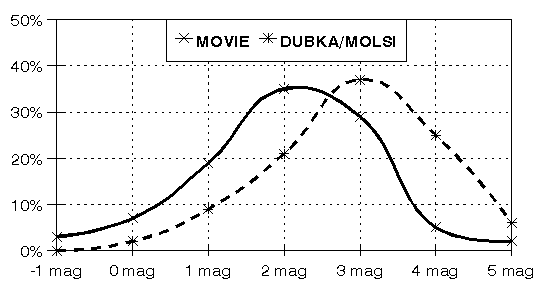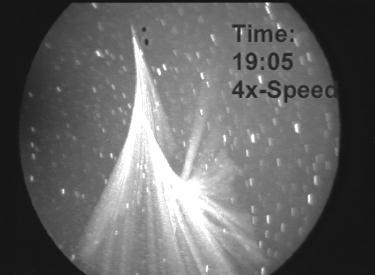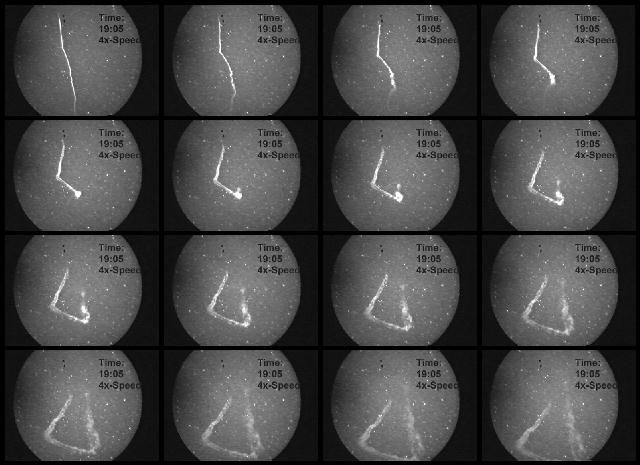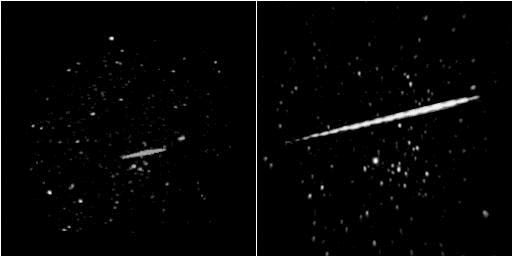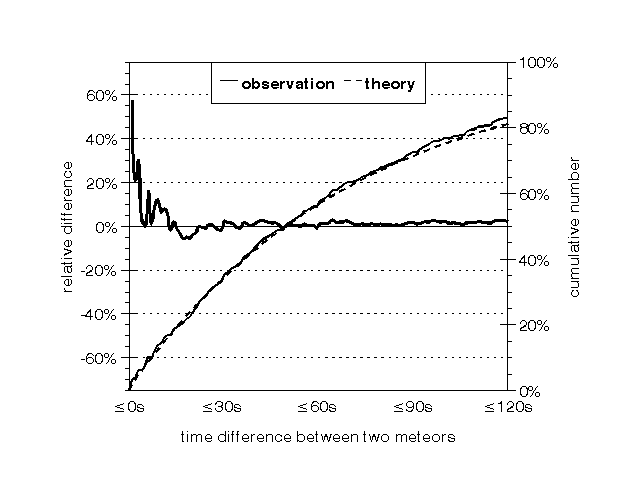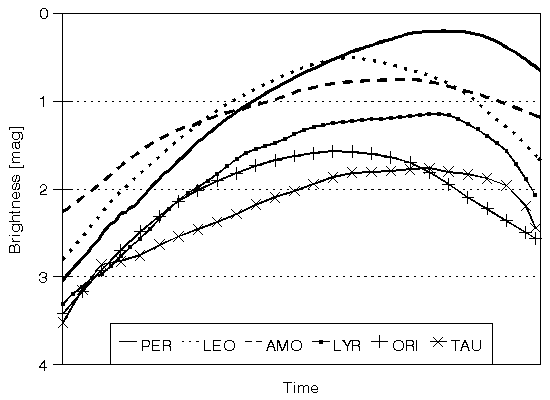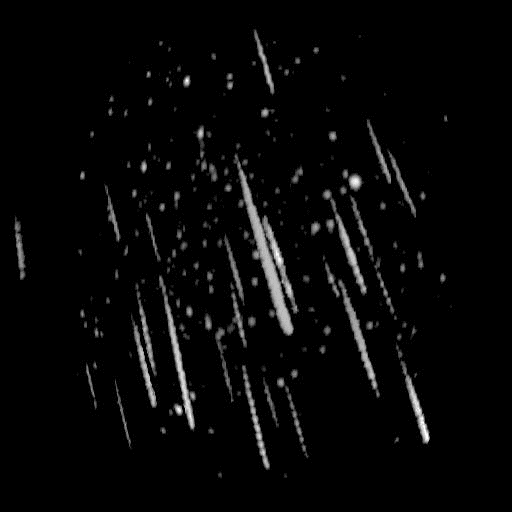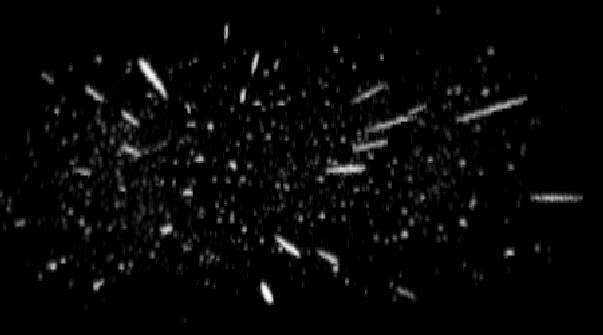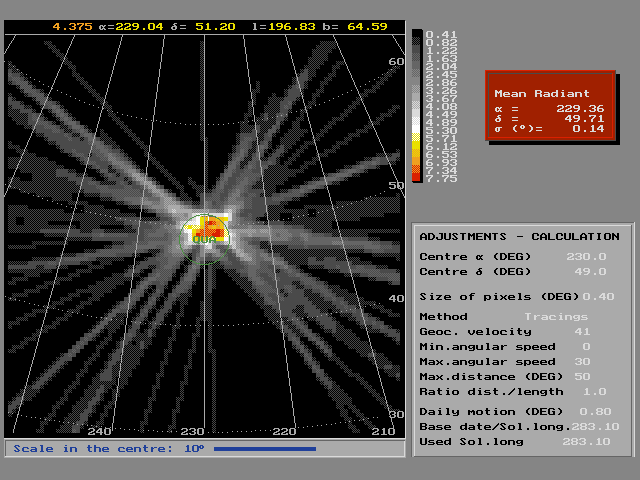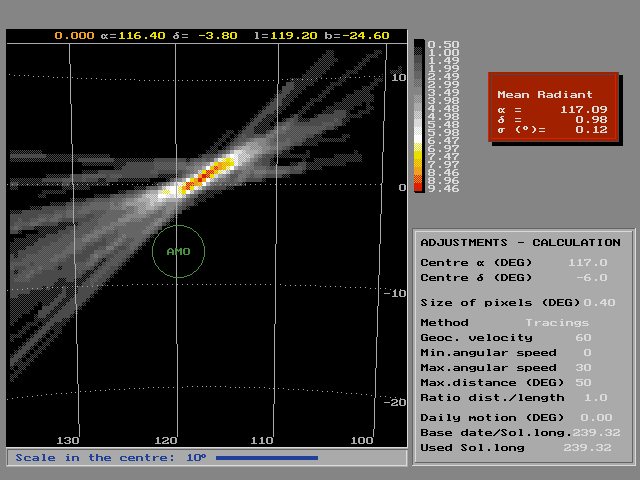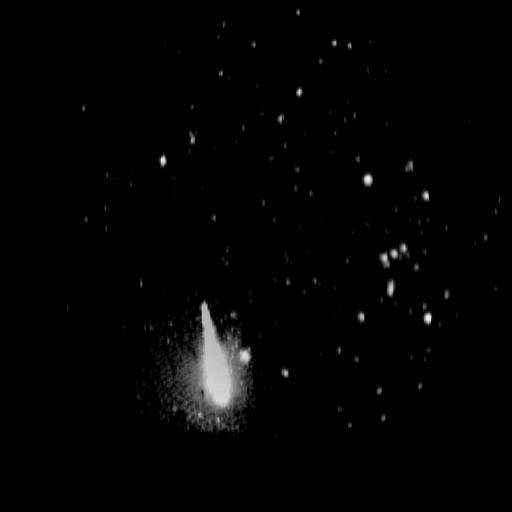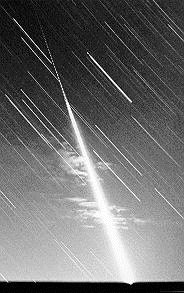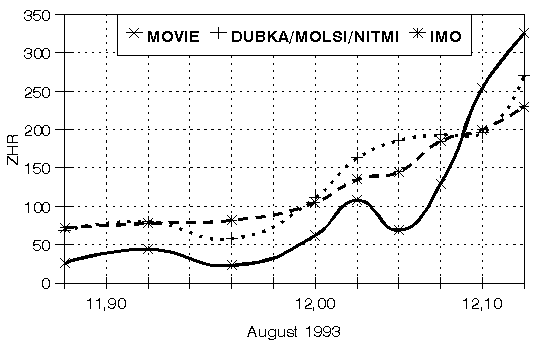Results from investigations with video systems have been published by several groups. This section contains some investigation examples.
Comparison of video observations and other methods
The graph above shows the meteor brightness distribution of our video system MOVIE and two parallel working visual observers (DUBKA/MOLSI) in August 1994. There is a significant shift in the visual curve, although only meteors that were seen from both video system and human observers contributed to this figure. It is obvious that visual observer underestimate the meteor brightness by about 1 mag, a trend that was supported from other parallel observing sessions.
Development of persistent trains
Photographs of persistent trains usually look like in the example above. When you take pictures of a persistent train with long exposure time, the structures will completely smear out due to the fast development of the train. In the best case, you can obtain a number of short exposure images (from which the sum image above was generated).
With an image intensified video camera, however, you can record the development of persistent trains in full detail! The train shown here was recorded during the German Leonid expedition to Mongolia on November 16/17, 1998. Beside a number of unguided video systems we operated one camera that was especially devoted to persistent trains. Every time a fireball was seen, the operator immediately moved the camera in that direction.
Due to the extended infrared sensitivity of image intensifiers and the improved limiting magnitude (about 8 mag), the trains were visible much longer in the video than visually. In this case, a fireball of about -8 mag left a train, that remained visible for more than 5 minutes.
![[persistent train]](http://www.imo.net/docs/images/vdemo5.gif)
Images from meteors and fireballs
This picture shows two recordings of the same meteor. On November 21/22, 1995, we had the fortune to witness and capture the incredible outburst of the Alpha-Monocerotids visual and with two parallel mounted video systems in Chemnitz (Germany). The left image was taken by MOVIE, a wide angle video system with a 2.8/20 mm photo lens, an first generation image intensifier and a Camcorder. The right picture comes comes from VK1, a prototype for a new video camera series with an 1.4/50mm photo lens, a second generation MCP and a video camera module.
The image processing was done with the appropriate analysis software for video meteors.
Meteor cluster search
Meteor observers have been discussing meteor clusters for quite a long time. Nevertheless there has been no positive proof for this effect so far. Video observation provides very accurate data to decide this question once and forever.
The graph above results from our latest investigation in this area. It shows almost no clustering effect at the Perseid maximum 1993, that was recorded by MOVIE in the Schwarzwald Mountains (Germany). The sequence of meteors follows without doubt the theory for randomly distributed particles in space. Nevertheless there seems to be a minor surplus of meteor pairs with very short distances, which is only prominent in the plot of the relative differences.
Meteor light curves
This graph shows average light curves for several meteor showers that were observed with our video system MOVIE at different places in Germany between 1993 and 1995. Beside the different average meteor brightness each shower seems to have characteristic features which are subject of further investigations.
Meteor shower images
Once you have recorded a bigger number of meteors belonging to one shower it is possible to create nice shower images. All meteors in the picture above appearead in the summer triangle on August 09/10, 12/13 and 13/14, 1994. They were recorded with MOVIE during our annual summer camp in Krampfer (Germany). The meteor brightness varied between – 1 and +3 mag. All Perseids appear in parallel since the recorded sky area was approximately 90 degrees away from the radiant.
A completely different picture will be obtained if you record meteors near the radiant. On April 22/23, 1995, we observed the maximum of the Lyrids. We changed the field of view of the video system two times during the course of the night, so we could record meteors on both sides of the radiant. The resulting shower image contains a much larger portion of the sky (approximately 120° x60° ), it reaches from Bootes in the lower right to Cygnus in the upper left corner.
Meteor spectra
![[meteor spectrum]](http://www.imo.net/docs/images/vdemo11b-291.jpg)
From the spectra of meteors it is possible to derive both the meteroids chemical composition and the excited atoms and molecules from the high atmosphere that produced the shooting star phenomenon.
The picture above was taken photographically by Ed Majden (Canada) in 1983. To obtain spectra that way you need a bright fireball, which is why meteor spectra are still quite rare.
The animation below comes from Ondřejov Observatory. They have been using image intensified video systems for recording meteor spectra for several years. The main problem of these systems is the limited dispersion due to the low spatial resolution of the intensifier. However, video spectra show the dynamic aspect of meteors very well. Some lines appear early in the spectrum and disappear soon, whereas other spectral feature show up later and persist for a much longer time.
![[meteor spectrum]](http://www.imo.net/docs/images/vdemo11.gif)
Radiant plots
An important task for video observers is the accurate determination of shower radiant positions. The plot above was generated with the program Radiant by Rainer Arlt. It shows the position of the Quadrantid radiant derived from 39 shower meteors. They were recorded by our video system MOVIE during an observation session near Hannover (Germany) on January 3/4, 1995. It is obvious that there is no deviation from radiant position found in the literature (green circle).
However, this is not always the case. On November 22/23, 1995, we were able to witness and record an extreme rare outburst of the Alpha-Monocerotids. This unique event lasted only about 20 minutes, so it was impossible to change the systems field of view. Even though the resulting radiant plot is far from beeing optimal due to this fact, it gives us for the first time an accurate radiant position for this shower. Obviously the few visual observations made so far resulted in an errorneous position by several degrees.
Slow motion sequences of meteors
On January 5/6, 1995, we recorded the -4 mag Delta Cancrid fireball shown above near Hannover (Germany) with our video system MOVIE. During the analysis all video frames of the meteor were digitized, processed and finally converted into an MPEG animation.
Of course, this sequence is not as thrilling as the Peekskill fireball from October 9, 1992, but that event was recorded by spectators of a football match in the United States by pure chance. In fact it was the first video record of a meteorite fall, where the corresponding object was found later: the meteorite crashed into the trunk of a car.
Anyway, there have been other interesting events recorded by video systems: Klaas Jobse and Marc de Lignie found three strange ‘worm meteors’ that look quite different than all the other thousands of shooting stars they have been catching on video tapes so far. The animation shows the brightest event from October 18, 1987, 3:31:40 UT. The video system they used contained a second generation image intensifier as the main component.
Sonic booms from fireballs
Many video systems apply a Camcorder as the recording device. The advantage of their use are audio records parallel to the video image of the scene. With that you are not only able to catch the cry of observers having just witnessed a fireball, but sometimes the fireball itself!
During their Leonid expedition to Spain Dutch observer from the DMS had the fortune to record a rare sonic boom of a bright fireball (photo below) that appeared on November 17/18, 1995. Four minutes after the visual event two loud detonations were heard at Zafarraya and could be registered from the video system built by Klaas Jobse. Unfortunately the quality of the recording was low due to different noise sources, however, after low pass filtering the signal the booms became much clearer. The graph above shows the amplitude of the recorded sound event.
ZHR calculations
As the number of meteors detected with video systems is generally quite large, you can calculate hourly rates (ZHR) for different meteor showers. The three graphs in the diagram above belong to our video sytem MOVIE, three parallel working visual observers (DUBKA/MOLSI/NITMI) and the results of all IMO observers on August 11/12, 1993. We recorded the Perseids maximum in the Schwarzwald Mountains (Germany).


